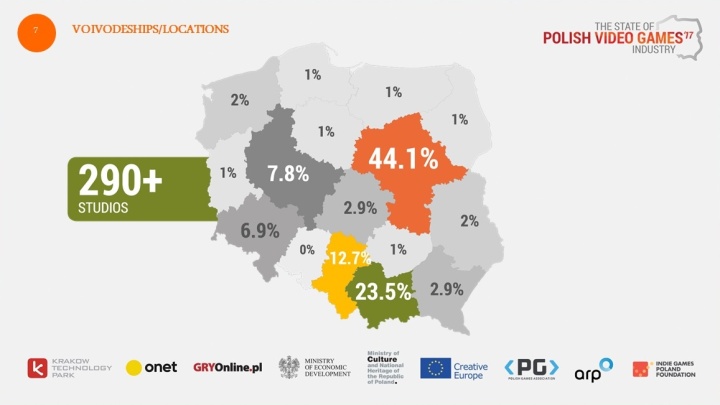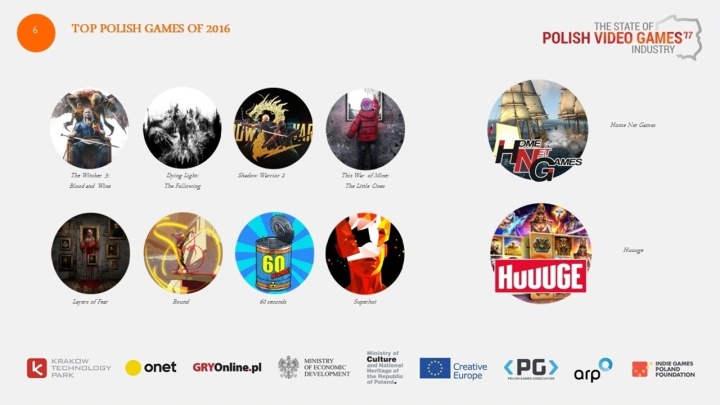The state of Polish gamedev as of 2016
Games made in Poland - such as The Witcher 3, Dying Light, or This War of Mine - have earned worldwide acclaim. Let's take a closer look at Polish game dev scene as a whole.
This week Krakow, Poland, hosts the biggest game industry conference in Central Europe – Digital Dragons 2017. As usual, the organizers have conducted detailed research of the state of Polish game industry. Below you will find information on Poland-based game developers.
Making games in Poland
There are currently more than 290 studios in Poland, 13 of which are listed on the stock exchange. 73.5% of that number are small teams of up to 10 employees, while bigger studios (50 people up) make up only 8.8%. In 2016 all Polish games generated a total revenue of PLN 1.25 billion (USD 335 million), 56.8% of which comes from the 13 companies listed on the stock exchange.

If you were to meet an average Polish gamedev employee, that would be a young (31 years old, on average), educated male, who is upwardly mobile and switches jobs about every 2.5 years. On the other hand, more and more women are joining the industry, but still make up only 15%. Polish studios have also recently started to hire foreigners, most often at Art-related jobs. Foreigners amount to 8.9% of all employees hired by Polish studios, and the majority of them have been working at their current company for up to a year.
Successes of Polish games
In 2016 there were several hot games made in Poland. The most successful of them were: The Witcher 3: Blood and Wine (CD Projekt RED), Dying Light: The Following (Techland), Shadow Warrior 2 (Flying Wild Hog), This War of Mine: The Little Ones (11 bit studios), SUPERHOT (SUPERHOT team), Layers of Fear (Bloober Team), Bound (Plastic Studios) and 60 Seconds (Robot Gentleman Studios) – these are not all big AAA productions, some of them are just really good indie games.

Platforms and business models
Since most game devs in Poland are small indie studios, it is not surprising that 89.2% of Polish games are released for Windows PC (48% Mac, 38.2% Linux). There are also plenty of mobile games (60,8% Android, 56,9% iOS). The leading consoles – Xbox One and PlayStation 4 – only get 36.3% of all titles released by Poles. At the very end there are: Windows Phone (19.6%) and handhelds (5.9%).
Polish people respect few things as much as tradition. That’s probably why the lion’s share of all their games are based on the traditional premium business model. On the other hand, one would be a fool to neglect the rising free-to-play format, which is the second most popular model there – 22.2% of games made in Poland are F2P. Only 2% are subscription-based games.
Challenges
Polish game dev is a growing industry, and has become very promising in the recent years. However, the local developers name several factors that make the growth harder than it could be. Some of these are bureaucracy and administrative obstacles, lack of qualified personnel in the market, complicated and confusing tax rules and high taxes as well as high volatility of the video game market. Members of the industry think that existing government assistance programs generally run in an invalid form or have inadequate scope. In the near future they hope for more tax exemption, better international promotion, co-funding of game production, and better educated students.
- Poland
- surveys and research
- gaming market in Poland
- developers
- Polish games
- Condition of the Polish Video Games Industry
- Digital Dragons 2017
0
Latest News
- Steam has revealed the biggest winners of 2025. Game of the Year didn't make the list
- Clair Obscur players see „inspiration” from Game of the Year 2025 in a new title from China, much to the annoyance of jRPG fans
- Dark Souls creator doesn't consider himself the father of the new action RPG genre
- 3 games to claim on Amazon Prime Gaming, including a cyberpunk RPG from the iconic series
- Discovery in RDR2 after 7 Years. Mysterious phenomenon appears only at night

